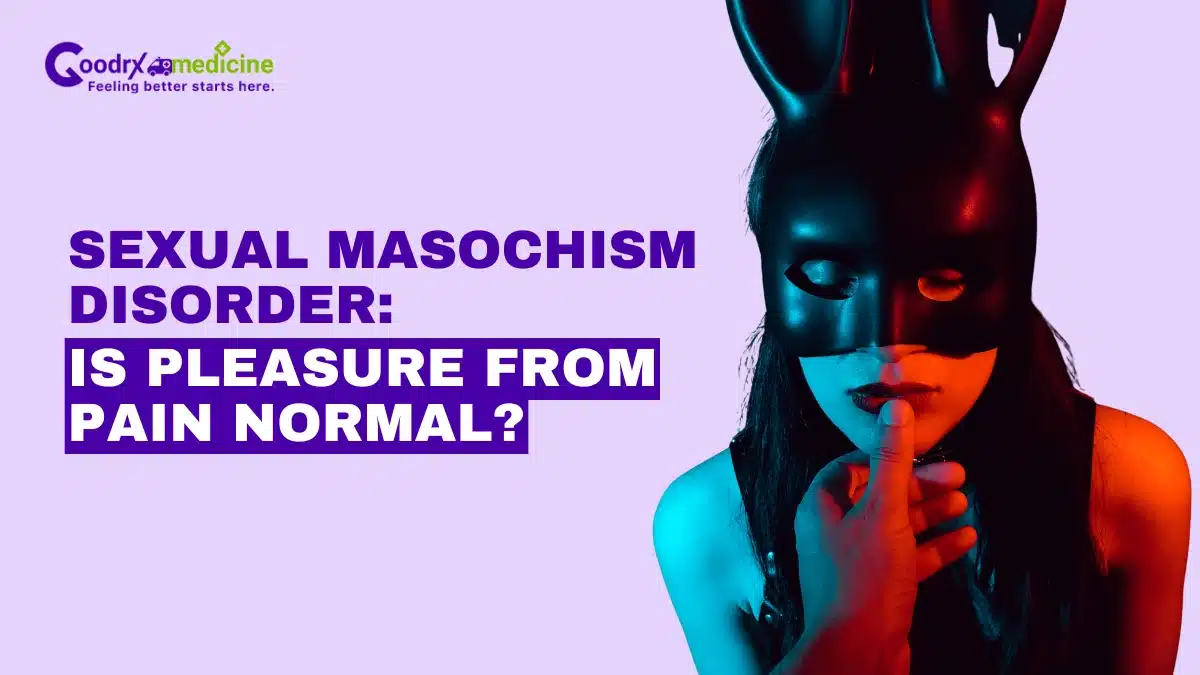Paraphilic disorders are a diverse group of mental conditions where unusual sexual interests lead to distress, impairment, or the risk of harm to oneself or others. While often discussed in hushed tones, these disorders are more present in society than many assume.
Recent research suggests that nearly half of adults express an interest in at least one paraphilic category, with Sexual Masochism Disorder (SMD) standing out as a notable example. Unlike occasional fantasies or consensual activities, it’s the distress or life disruption that distinguishes a paraphilic disorder, like SMD, from mere curiosity or preference.
It involves deriving sexual arousal from being humiliated, hurt, or otherwise made to suffer. These interests reflect the complexity of human sexuality and raise essential questions about stigma, diversity, and psychological well-being. All of these questions about SMD, including symptoms, causes, and treatment, are covered in this article.
What is Sexual Masochism Disorder?
Sexual masochism involves intentional participation in painful activities to experience sexual pleasure or excitement. These activities may include elements of humiliation, physical impact, bondage, or other forms of consensual power exchange. It is different from Sexual Sadism Disorder (SSD), which is getting sexual pleasure from causing pain to the partner.
Sexual Masochism Disorder (SMD) is diagnosed when a person experiences recurrent, intense sexual arousal from these activities. According to the American Psychiatric Association (APA), an individual with SMD experiences clinically significant distress or impaired functioning.
SMD involves consenting adults and is classified under paraphilic disorders in the Diagnostic and Statistical Manual of Mental Disorders (DSM-5). Acknowledging that these behaviors are consensual and separate from non-consensual harm is essential.
Save up to 90% on your medicine bills

Cenforce 100 mg

Cenforce 200 mg

Kamagra Oral Jelly Rx 100 mg

Vidalista 60 mg
Symptoms of Sexual Masochism Disorder
Sexual Masochism Disorder symptoms include recurrent or intense sexual arousal, fantasies, urges, or behaviors involving the experience of physical pain, humiliation, or suffering.
These symptoms may cause distress or impairment in daily functioning. Let us have a closer look at the symptoms:
- Frequent and vivid sexual fantasies that involve themes of humiliation, pain, or suffering within a sexual context.
- Strong sexual arousal and excitement in response to thoughts or situations involving pain, humiliation, or suffering.
- Strong urges to engage in behaviors that may involve pain, humiliation, or suffering for sexual satisfaction.
- Participating in consensual activities like bondage, spanking, or other forms of pain or humiliation is part of their sexual preferences.
- The fantasies, urges, or behaviors may result in noticeable distress, Anxiety, disruption in daily life, or difficulties in social, occupational, or other areas of functioning.
These symptoms are only considered a disorder if they occur repeatedly, are intense, and cause distress or impairment over time.
It is essential to approach discussions of sexual behaviors and disorders with a neutral and respectful attitude. If you suspect that you or someone you know may be experiencing Sexual Masochism Disorder symptoms, it is advisable to seek guidance from mental or sexual health professionals.
Sexual Masochism Disorder causes
The causes of Sexual Masochism Disorder (SMD) are complex and can involve psychological, social, and biological factors. The exact cause of SMD is not fully understood, but several potential contributing factors exist. They can vary from person to person.
Factors like genetics, life experiences, and psychological traits contribute to the development of this condition.
1. Psychological factors
The psychological factors contributing to the development of SMD include:
- Early experiences: Childhood experiences, such as exposure to certain stimuli or events, could influence the development of SMD.
- Conditioning: Classical conditioning can make individuals associate pain, humiliation, and suffering with sexual arousal.
- Fantasy and imagination: Different fantasies and vivid imagination levels may influence sexual preferences and behaviors.
2. Trauma and coping mechanisms
Certain traumatic experiences could lead to SMD in some individuals. It may develop as a coping mechanism to deal with or gain control over past experiences. Sometimes, engaging in sexual masochistic behaviors might help escape emotional pain or distress.
3. Biological factors
The biological factors that could cause SMD in individuals include:
- Neurotransmitter activity: Neurotransmitter activity in the brain can affect how pleasure and arousal are experienced, even in response to pain or humiliation.
- Hormonal influence: Hormonal changes or imbalances may cause unusual sexual responses.
4. Social and cultural factors
Social factors can significantly impact a person’s sexual preferences. A person can develop SMD due to:
- Media and culture: Media, cultural norms, or subcultures that eroticize pain or submission could affect a person’s sexual tastes.
- Peer influence: Social interactions and peer group dynamics can influence an individual’s perception of sexual preferences and behaviors.
5. Interpersonal dynamics
Interpersonal dynamics can affect an individual’s sexual preferences. It can lead to the development of SMD. Some of the examples are:
- Power dynamics: Some individuals might be drawn to power dynamics in relationships. They may seek a sense of control or submission that aligns with their sexual preferences.
- Attachment patterns: An individual’s attachment style and relationship dynamics could influence their preference for certain sexual behaviors.
Treatment of SMD
Sexual Masochism Disorder treatment typically involves an inclusive approach. Some of the options mentioned below can be used alone or in combination to develop healthy sexual habits:
- Cognitive-Behavioral Therapy (CBT): This approach helps individuals identify and change thought patterns and behaviors that fuel masochistic urges.
- Selective Serotonin Reuptake Inhibitors (SSRIs): These may lower high sexual drive and alleviate related mood symptoms.
- Psychodynamic/Psychoanalytic Therapy: By exploring unconscious influences, such as past trauma or childhood experiences, this therapy targets contributing factors to the disorder.
- Trauma-informed Therapy: Addressing underlying trauma is the main focus of this therapy. It is sometimes through techniques like Eye Movement Desensitization and Reprocessing (EMDR).
- Group therapy: Joining a group provides support, reduces shame, and allows individuals to learn coping strategies through shared experiences.
- Sex therapy: Professionals address sexual concerns and work with individuals and couples to manage distress or relationship issues linked to masochism.
- Harm reduction/safety planning: Strategies are taught to minimize risk and encourage safer sexual expression.
- Antiandrogen or hormonal therapy: Lowering Testosterone to reduce sexual impulses is considered in severe cases, due to possible side effects.
- Psychoeducation and supportive counseling: Individuals gain information about the disorder, experience reduced shame, improve self-understanding, and receive relationship support through these avenues.
- Couples/relationship therapy: This therapy addresses relationship impacts and helps improve communication with partners.
Conclusion
Sexual Masochism Disorder is a paraphilic condition where sexual arousal stems from pain, humiliation, or suffering. While consensual masochistic activities can be part of healthy sexual expression, SMD involves persistent, intense urges, fantasies, or behaviors that interfere with well-being.
Its causes include psychological influences, past trauma, biological factors, social norms, and interpersonal dynamics. Effective treatment is individualized and may involve therapies such as CBT, psychodynamic therapy, trauma-informed approaches like EMDR, group or sex therapy, medication, and harm-reduction strategies.
Addressing SMD requires prioritizing consent, safety, and emotional health while reducing shame and promoting healthy relationships. Seeking help from qualified mental health or sexual health professionals can lead to improved coping, self-understanding, and overall quality of life.

Frequently Asked Questions
Is SMD the same as BDSM?
No, while both involve consensual activities, SMD specifically refers to intense sexual arousal from pain or humiliation. BDSM encompasses a broader range of consensual power dynamics and sexual activities that are not necessarily related to pleasure from pain.
Is sexual masochism common?
No, sexual masochism is quite uncommon. Estimates of its prevalence vary due to the sensitive and private nature of the behavior. Not all instances of masochistic behavior necessarily indicate a disorder. It is only diagnosed when it causes distress or dysfunction.
Is masochism a mental disorder?
No, masochism itself isn’t a mental disorder. Sexual Masochism Disorder is a mental disorder only diagnosed when masochism causes distress, dysfunction, or harm. The distinction is based on whether the behavior causes impairment or is consensual and controlled.
Are there any legal considerations related to Sexual Masochism Disorder?
Yes, legal considerations arise primarily if activities involve non-consenting individuals, causing harm or violating laws. Consensual adult practices within safety boundaries generally have no legal issues, but non-consensual acts can lead to criminal charges and legal consequences.
When referencing outside resources, GoodrxMedicine always provides full citations. To learn more about the measures we use to maintain the quality of our content, please review our Content Information Policy.











